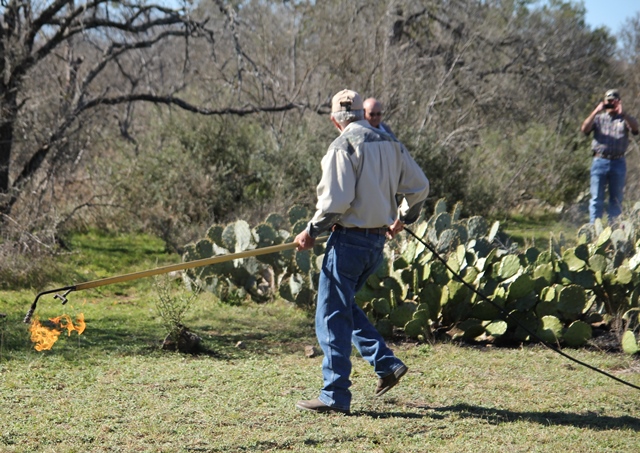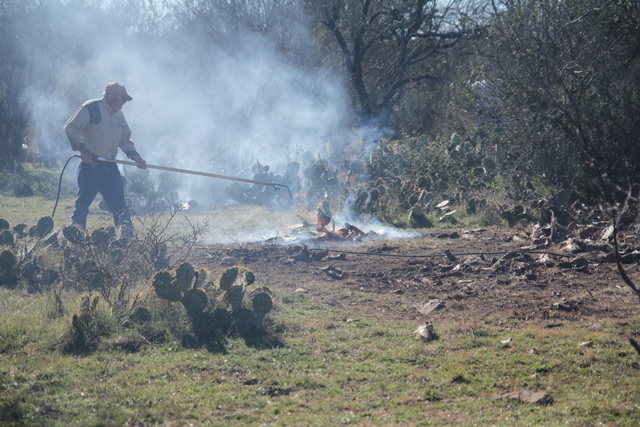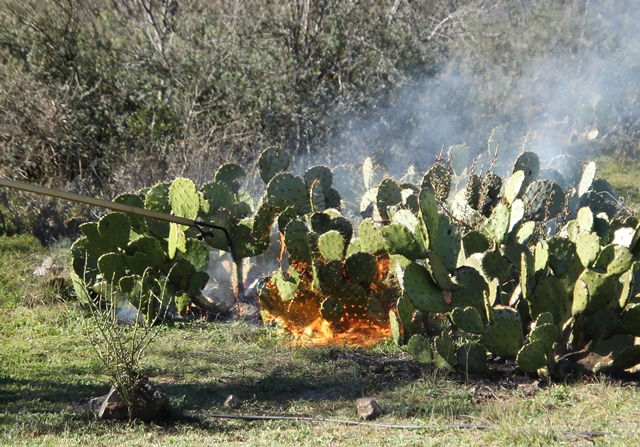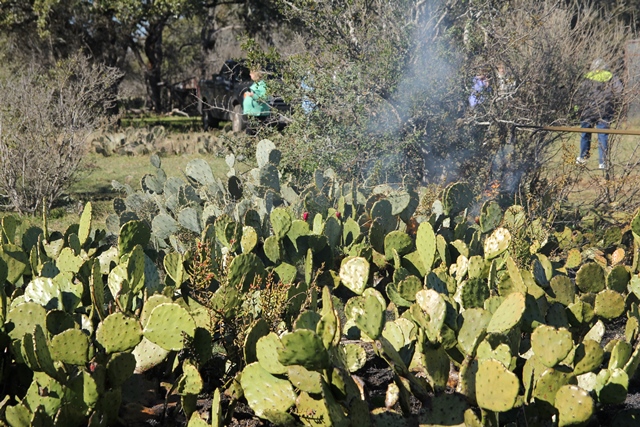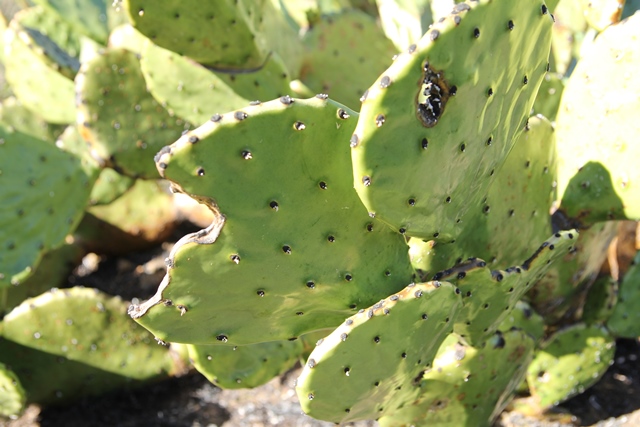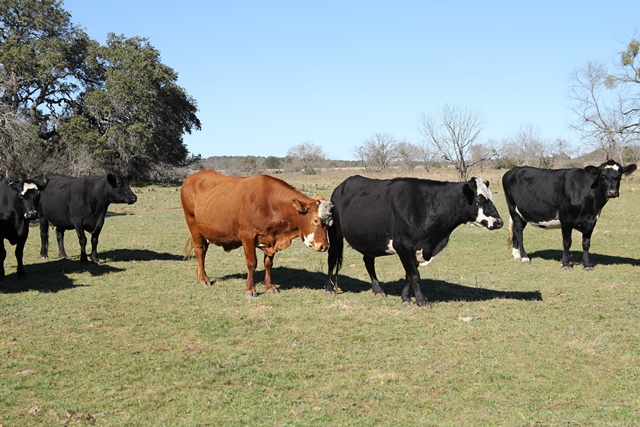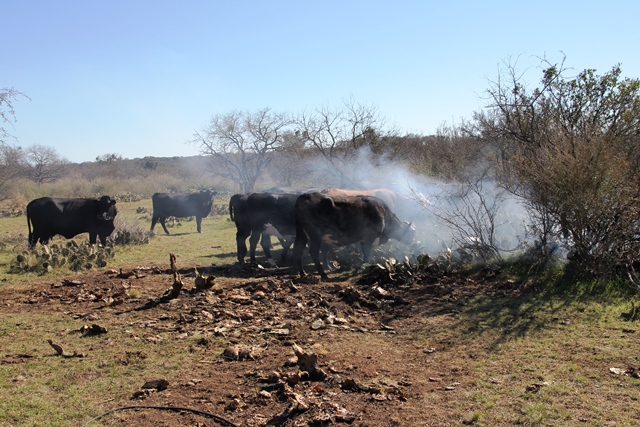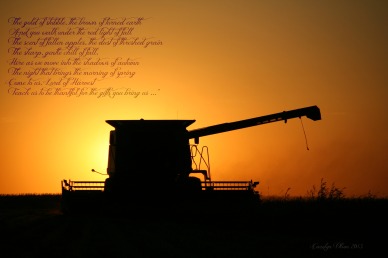The post Farm to Fork Class Comes to the Farm appeared first on Carolyn CAREs.
]]>The day dawned cold and windy with 100% chance of rain. We had tractors and machinery parked in the shop and the machine shed so we wouldn’t have to stand outside. I was very thankful that Jonathan and Adam took the time to clean the shop so we could meet in there…and they even turned the in-floor heat on again. In April in Minnesota, it’s not unusual to go from heat to air conditioning to heat in the span of a week.
We started out in the shop where we had our planter tractor parked with the corn and soybean planter attached. We talked about how the planter works, and how we use GPS technology to plant in a straight line, and how we can adjust the depth the seeds are planted according to the recommendations for that seed. Many of the students have helped plant gardens, so they understand the importance of planting the seeds at a proper depth. We also talked about how we use computers to plant just the right number of seeds in an acre, and how we can adjust that depending on soil types. The three monitors we have in our planter tractor were running so the kids could see what kind of information we use when we’re planting. They were able to climb up into the tractor if they wanted.
While in the shop, we also talked about the records we keep and the process we go through to become a certified organic farm. We had our Organic Systems Plan, Clean Truck Affidavits, and Yield Maps & Soil Tests books that they could page through.
Next we walked over to the machine shed. Fortunately, it wasn’t raining yet. The machine shed was chilly, but at least we were out of the wind! Jonathan talked about the field cultivator and the tractor that pulls it, and how we can change the tracks on that tractor to narrow ones that will fit in between our 22 inch rows if we need to. The kids were standing around the pallets of seed that were waiting to be delivered to our seed customers, but they didn’t seem to mind.
The rotary hoe is parked to the left of the tractor in the photo, so we walked over and talked about why and how we use it. Then we turned and talked about the combine. It was a good time to talk about farm safety as well. The kids could see the size of the machine up close, and realize that this isn’t really meant to be on the road. I hope the message of giving the combine room in the back, and only passing when it is safe to pass is a message that sticks! The kids had the chance to climb up into the combine cab and up on the back to see what it looks like. I think they liked this part!
We viewed the flame weeder from the door of the machine shed, since it was starting to rain at this point. Back in the shop, we gathered around our newest project, a cultivator. This cultivator has a camera that “sees” the crop and adjusts the cultivator’s position accordingly. I’ll explain that a bit more in another post.
The kids were able to put their hands in a bucket of wheat seed, and we talked about how the seed we plant becomes the food they eat. Sometimes King Arthur Flour buys our wheat through one of our grain buyers. We also have sold corn and soybeans to dairy and poultry farms to supply feed for their animals. To help connect the farm to fork concept, I baked some of my favorite scones for our guests using ingredients that could affect our farm when they are purchased by consumers. The King Arthur Flour, and Organic Valley dairy products are two of our potential markets. The organic sugar and egg may not directly affect us, but show that those choices are available to consumers in southwest Minnesota. The ground vanilla beans are there because I love using ground vanilla beans in my baking, even though it is considered a premium ingredient.
The students asked some great questions, and know they have someone they can ask when something comes up that they want to understand a bit more. One of the reasons why I love to share my farm story with groups, and why I love hosting groups on our farm is that connection I now have with all those I visited with.
It is important to Jonathan and I that we show consumers the impact that farmers and agriculture have on them. We talked about how Jonathan and I are giving consumers a choice by farming organically, and that we don’t mind what their families choose, since agriculture is filled with farmers and farm families like ours. No matter what they purchase in the grocery store, it started on a farm.
To me, there is no better way to cap off a morning on the farm than by eating a vanilla bean scone with a carton of Organic Valley Chocolate Milk served from the workbench. Thanks to the students for being awesome, and thank you to Mrs Campbell and Ms Noll for making both visits possible!
Some might think it is scary to host a Farm to Fork or Family and Consumer Sciences class at their farm. It doesn’t have to be fancy, you don’t have to be an expert on everything. Most of the kids just want the chance to meet a farmer and get a little hands on feel for what it takes for the food they eat to get to their table. If you are interested in hosting classes, contact your Farm Bureau and see if they have programs that will help you connect with teachers.
A huge shout out to my friend, Emily Zweber of Zweber Farms for supplying the chocolate milk…and to Jonathan for cleaning up the shop, getting equipment parked inside, and talking about farming to the Farm to Fork class…and to our hired dude, Adam, for cleaning the shop with Jonathan, and picking up after us and turning off equipment and turning out lights when we were done.
The post Farm to Fork Class Comes to the Farm appeared first on Carolyn CAREs.
]]>The post Cover Crop Residue Tour appeared first on Carolyn CAREs.
]]>We have a three crop rotation on our farm. Each year one-third of our acres are planted into corn, one-third is soybeans, and one-third is a small grain such as wheat. After the wheat is harvested, we apply hog manure to that land for the corn to use the following year. After the manure is incorporated, we plant our cover crop. The root systems of the oats and Tillage Radish are very different, but work in harmony to improve soil health. The oats stimulate microorganisms in the soil that digest the organic matter making the nutrients available for the corn to use in the spring. Oats are also good at suppressing weeds. The Tillage Radish tap root breaks up compacted soil, and creates water channels that help the soil to hold water instead of the water running over the top. Both the oats and Tillage Radish are good at storing nutrients from the manure in their stems and roots, which are released when the organic matter is worked into the soil in the spring.
Here you can see how the stems from the oats formed a thick layer over the soil. This field had no wind erosion this past spring, even though we have had some extremely windy days. The soil underneath was cooler and wetter than our fields without a cover crop.
We were looking for some Tillage Radish residue and the holes they leave behind. The end rows in this field only had Tillage Radish planted, due to timing issues. It also makes for a good experiment to have just the radish in areas that typically suffer from compaction issues. We found a few rows where the tops of the radish were above ground, so we could look at how they decompose.

You can see how Jonathan was able to tease the radish out of the ground. The top of the radish was exposed through the winter, and was a little spongy when squeezed.
You can see how part of the root has decomposed, yet some remained. This was the part just under the soil line. It was much softer than the top of the plant.
Here I was trying to see how deep the root channel was. I couldn’t touch the bottom. The root channels vary in size depending on how close the radishes were planted, and how large they grew.
This hole wasn’t as big in diameter as the other one, but was very deep. When it rains, these holes give the water a place to go instead of the rain just running over the top of the soil. It is one reason we use our corn planter to plant the Tillage Radish in rows. When we plant corn over the same rows in the spring, the corn benefits from the moisture held in the soil.
Using a cover crop has become an important part of our rotation. We are seeing the benefits in increased soil organic matter, better water holding capacity, and better erosion control. We are also seeing benefits to the environment in wildlife activity (deer love the tillage radish), water holding capacity, and erosion control. A true win win!
The post Cover Crop Residue Tour appeared first on Carolyn CAREs.
]]>The post Remembering Kenny appeared first on Carolyn CAREs.
]]>
My father-in-law, Kenny Olson, passed away on January 22, 2016. I have been mulling over ways to pay tribute to the man who taught me so much about farming, about living out your wedding vows so faithfully, and handling life’s difficulties with humor and grace. In essence, he showed us all how to live out our faith.
These verses in 1 Corinthians 13 really sum up much about what I know about Kenny.
4 Love is patient, love is kind. It does not envy, it does not boast, it is not proud. 5 It does not dishonor others, it is not self-seeking, it is not easily angered, it keeps no record of wrongs. 6 Love does not delight in evil but rejoices with the truth. 7 It always protects, always trusts, always hopes, always perseveres.
When Jonathan and I were dating, we lived 3 hours from each other. This meant visits to the Twin Cities for Jonathan, or trips to the farm for me when we wanted to see each other. I was pretty nervous the first time I came to the farm and met Kenny and Lois. Thankfully, they were both so welcoming that I felt better immediately. I think he was pleased when we were engaged on his birthday in 1988.
Kenny and Jonathan were so patient teaching this city girl how to drive tractors, pick rocks, hoe weeds, and run to town for parts. If he was upset at me about mistakes, he never let it show. There was a time when Kenny and Lois had guests stop by for an evening of visiting while we were still working the ground after harvest. I volunteered to take the evening shift in the tractor to chisel plow so Jonathan and the girls could hang out at the farm and visit with the guests as well. I was on the far end of the field when all of a sudden, the chisel plow fell off the hitch, hydraulic hoses flying. Neither Jonathan nor Kenny had their two-way radios on, so my only choice was to drive back to the yard, leaving the chisel plow where it was. The guys were a little surprised when I drove in to the yard, and were happy I was not hurt, and that the hydraulic hoses had pulled cleanly out of the outlets on the back of the tractor and were in one piece. Neither one of them were upset over that incident. They just made sure the large pin was held in place with wire after that, so it couldn’t get jerked out of the hitch again.
My mother-in-law, Lois, lived with Multiple Sclerosis for 30 years. Kenny lived out the wedding vows, “in sickness and in health” so beautifully. He wasn’t real fond of driving into the Cities to take Lois to medical appointments, but he did it anyway. When Lois needed to use a wheel chair, he had a ramp built to get her in and out of their home, and made other modifications to make her life easier. When it came time for Lois to move to a nursing home in a neighboring town, he drove the 22 miles to pick her up for church every Sunday morning, then brought her to their house in town for the day before returning her to the nursing home in the evening. He spent many days visiting her when he wasn’t helping on the farm. I know it wasn’t all sunshine and roses dealing with Lois’ illness, but he chose to live out his love through patience and devotion to her. That has been a great example to all of us.
Kenny had a wonderful sense of humor. When we were looking for photos for our farm’s 100th anniversary celebration, we found many photos of Kenny and his brother having fun. Apparently, they liked to pull old Model T cars, without engines, behind other cars and run them up and down the road ditches. Kenny also enjoyed telling stories and having fun, even while hoeing out weeds in the soybean fields. He found a way to make the unpleasant tasks more tolerable with humor. The last month of his life, even after the dementia caused him to no longer recognize his family, he would still make people laugh with self-depreciating humor, and joking. He had such a pleasant nature, that everyone who worked at the memory care unit where he lived loved him.
Kenny has been such a great example of living out your faith, even when life gets hard. I feel so blessed to have been able to be a part of his family for the past 27+ years.
The post Remembering Kenny appeared first on Carolyn CAREs.
]]>The post Water Quality – Don’t Put all Your Eggs in the Buffer Basket appeared first on Carolyn CAREs.
]]>
In January, Minnesota’s Governor Mark Dayton announced a plan to require a 50 foot buffer strip along all rivers, streams, and drainage ditches in the state. Mandating a set buffer strip width for all of those waterways means topography, soil types, and surrounding land use will no longer be determining factors in buffer strip width. This one-size-fits-all approach won’t improve water quality like we’ve been told it will.
The NRCS (Natural Resources Conservation Services) published a report in 2000 that talked about the different types of water control features that would help trap soil, nutrient, and pesticides, which would help to improve water quality. In the report, they stated how using multiple methods was more effective than a single method for controlling water flow, water filtration, and pesticide trapping. Many improvements have been made in the 15 years since this report was published. Let me highlight a few for you.
Cover crops
The use of cover crops is a relatively new trend in our area. Cover crops are a blend of plants grown for their ability to prevent soil erosion, manage water and water quality, suppress weeds, and hold soil nutrients in place. We plant our cover crops right after our wheat is harvested which will give the plants enough time to grow well and be more effective. Other farmers will use airplanes to spread the seed before their row crop is harvested. In the 14 years that we have been growing cover crops, we have experimented with different seed mixes until we found what works best on our soil. The combination of tillage radishes and oats that we use provides two very different types of plants which is also beneficial for wildlife. The deer graze on the tillage radish leaves, and pheasants use the taller oats for cover. This is a win-win for water quality, soil health, and wildlife.
Field Mapping
Global Positioning Systems (GPS), broadband internet, and computers in combines and tractors have made it possible to create accurate maps of every field. These maps are uploaded onto a computer, where we can then work with our local agronomist to determine what recipe each field needs to grow the crop that will be planted in it. Each recipe will be different for each field, depending on what we will be growing, the results of our soil and plant tissue tests, and the yield data from the year before. Our corn and wheat both need manure applied to supply the nutrients that the plants need to grow well. However, they do not require the same amount of manure, so we follow the recipes to make sure we are not using too much manure on the fields. We like to use cover crops as part of our recipe for our corn fields, since the tillage radish helps to keep the nutrients from the manure where the corn roots will be. This combination of conservation methods works great over an entire field to keep soil and nutrients from eroding, and doesn’t just rely on the last 50 feet before a water way.
Precision Equipment
Fifteen years ago, I never imagined all of the things computers and information technology could do for agriculture. Of course, at that time, I was still using a Nokia cell phone with an external antenna, and the iPhone was still 7 years away from being released. Now, besides most farmers having smart phones, there are computers in tractors, fertilizer spreaders, and sprayers. These computers allow farmers to use their field recipes as they are driving up and down the fields, many times driving with the aid of GPS auto guidance systems. The Precision Planting computer we have in our tractor helps our planter keep the seed planting depth at the perfect level through the variations in the firmness of the soil, varies the amount of seeds per acre according to soil type, and will shut off boxes at the end of the rows or where the rows overlap on curves so we don’t waste seed. We work with our Precision Planting Specialist to make sure our recipes are entered into to the computer correctly, and that the equipment is communicating with the computer. Fertilizer spreaders with variable rate technology are used by our friends. Their field maps and recipes are loaded into the computer, and the fertilizer is spread where it is needed. A similar system is used with sprayers when applying pesticides. The field map can be set up to avoid spraying in certain sensitive areas, and to avoid overlapping the spray with auto shut off valves. We don’t use fertilizer spreaders or sprayers on our farm, so I would encourage you to go to your favorite farmer or The Farmer’s Life if you have questions.
Flexibility is needed
On our farm, we have planted some buffer strips with the help of our NRCS Conservationist and local Soil and Water Conservation District (SWCD). On one ditch where the ditch bank rises to the edge we have a very narrow grass buffer, which is all that is needed. We are also using cover crops, field mapping, and precision equipment. This multi-pronged approach to water quality, soil health, and wildlife habitat is a better approach than a mandate of every river, stream, and drainage ditch needing a 50 foot buffer. Some ditches or streams do not need a grass buffer, while some could benefit from one that is greater than 50 feet. Every farmer should be able to figure out what conservation practices will work best on their farm, and should be able to change those practices when needed. Farmers want to be able to hand down their land to the next generation. To do that, we need to care for the soil and water in the best ways we can. Putting all of our water quality eggs into one basket isn’t the best way to achieve that.
To read more on how this buffer strip proposal would affect Minnesotans, I highly recommend that you read this post by Sara Hewitt.

The post Water Quality – Don’t Put all Your Eggs in the Buffer Basket appeared first on Carolyn CAREs.
]]>The post 3 Phrases Agvocates Should Lose appeared first on Carolyn CAREs.
]]>
As agvocates, we share our perspectives of agriculture from the lens of our own truth. My lens, or filters will be different from all other agvocates, because I have different experiences and my farm is different from all others. Having that diversity is awesome when it comes to agvocating, especially if the main message is a unified one: Agriculture is important in the United States, and we are blessed to have the safest, most abundant food supply, with the best choices available to fit everyone’s desires. So, if we see things through our own lens, which gives us our own truth, how do we stand united?
Over the past 18 months, I have been to many conferences where speakers and consumer researchers have told the attendees to meet their consumers on an emotional level. We need to make them feel good, and help them understand that no matter what they purchase in the grocery store they are supporting a farming or ranching family. Looking at agvocating from that perspective, I see three phrases or ideas that we should lose in order to reach our consumers on that emotional level.
Food Shaming
It’s pretty safe to say that there isn’t a person alive in North America who hasn’t felt the sting of judgement from their friends or neighbors. Heck, some of us have felt the sting of judgement from our fellow agvocates. The most popular form of judgement is food shaming. Typically, it is seen as a totally granola mom telling all her friends they have to eat only organic to “properly” raise their children. There is a lot of outrage in those instances. When a mom who feeds her kids organic gets shamed, and told that she’s just wasting her money on a marketing scheme, is that any better? There isn’t as much outrage when that happens, but to me, shaming is shaming, and it needs to stop. We will never be the trusted source of information for consumers if we are making them feel bad about their choices. Bottom line: nobody wants to feel stupid for the choices they make. We lose their trust, and they go elsewhere for their information (Peta, HSUS, etc). We need to stop shaming our consumers…and each other.
#Stand4Science
I’ll admit that this hashtag and the accompanying tweets associated with it annoy me for a couple of reasons. First, most of the tweets have a “I can’t believe you don’t know this” attitude when telling people about some study or another that proves that biotech or whatever is safe. The problem with that attitude is, we make consumers feel dumb. How many people have a science degree, or can understand what the studies are saying? We’re told when giving speeches or agvocating in public to speak at a 4th grade level…I’ve read many study abstracts, and I can tell you, they are not written at a 4th grade level! The Center for Food Integrity’s 2014 research talks a lot about this very thing. We cannot forget about the impact that emotion plays when people are deciding whether or not to trust your truth. Secondly, many of the tweets associated with this hashtag make it sound like the only science in agriculture is biotechnology. When you think about it, biotechnology is a pretty small part of the science that goes into raising a crop, even if the majority of corn, soybeans, and cotton raised in North America are genetically engineered. We all need to pay attention to soil science, plant science (including weeds), pathology, animal science, and hydrology…not to mention computer science, and engineering. I know I’m missing some major ones, but you get the idea. Agriculture involves a lot of science, no matter what you grow. We just can’t assume that our consumers will “get” the science that we work with every day. Heck, I don’t understand the science that goes along with range management or animal nutrition, because I don’t ever work with that. Fortunately, I have trusted friends I can go to when I have questions. That’s what we need to be to our consumers.
Biotech is the only way to feed the world
I’ve had many great conversations about this phrase. Looking at it from an agvocating point of view, though, I think we need to lose it. As consumers, we are all a bit self centered. We want what we want when we want it. When we are making our way through the grocery store, we are not thinking about how many people in the world the average farmer is feeding. We are thinking about checking off our grocery lists, or we’re trying to remember what it is we needed as we’re being distracted by kids, neighbors who want to say hello, or the little old ladies who need help getting a bag of cat food into their cart. This message is being lost on the consumer. I don’t know about you, but I eat a pretty diverse diet. I like my cereal or eggs in the morning, but the rest of the day I’m eating a variety of meats, potatoes or rice, and vegetables. For snacks, I like fruits, or coffee. I don’t like eating the same thing all the time, because I get bored with it. There are what, nine genetically engineered crops on the market? Foods made with those crops do not make up the entirety of the average diet. We need the diversity in agriculture to make the whole system work. We celebrate diversity in every other aspect of our lives, why not in agriculture? When the whole choir only sings one note, there is no harmony. When my BLT has no L or T, it is just a bacon sandwich…but that actually doesn’t sound all that bad….
So, what should we be saying when we agvocate?
In our lenten series at church this year, our Pastor has been talking about not separating our faith from our every day life, but to treat it as we do everything else. The funny thing is, I have taken a ton of notes during his Sunday sermons lately, because they fit agvocating so well. The verse on the photo above summed up my feelings about how to agvocate effectively without running the risk of alienating other farmers or our consumers.
“Do nothing from rivalry or conceit, but in humility count others more significant than yourselves. Let each of you look not only to his own interests, but also to the interests of others. Philippians 2: 3-4”
How cool would it be if we all agvocated that way…doing nothing from rivalry or conceit, but in humility count others more significant than yourselves.
We can do this when we tell our story, since we know it better than anyone else. This also goes back to each of us having our own truth. Nobody can argue with you if you say, “On my farm, we do this…” or “On my ranch, we do that…” That is your story, and your truth. You can find things in common with your consumers if you write about things they may be able to relate to. They won’t relate to farming, but if you develop a relationship with them over a common topic, you will be their trusted source when you do write about agriculture.
I absolutely believe we can speak as a unified voice for agriculture, but it’s going to take a little change in attitude from all of us. Will you join me in supporting all of our farming and ranching families?
The post 3 Phrases Agvocates Should Lose appeared first on Carolyn CAREs.
]]>The post 30 Things I Love: Seasons appeared first on Carolyn CAREs.
]]>
I love living where we get to experience four distinct seasons. Just about the time I get bored with one, the transition to the next begins.
In the spring, I can’t wait for the flowers and the rhubarb to start emerging from the ground. They are a great indicator that spring work will soon begin as the soil temperature gets warm enough to start seeding wheat. I’ve said it before, and I’ll probably say it again, but there is nothing so sweet as the smell of freshly turned soil in the spring. This past spring, the soil was so beautiful as I was preparing the ground for planting, that I stopped the tractor and walked barefoot in it. It felt so good! After all of the seeding and planting is done, there is the anticipation of the plants germinating, and growing big enough to “row” the field…seeing plants all lined up neatly from end to end. This is also about the time that the apple tree is in full blossom, and looks beautiful.
Summer brings field work, and green. Trees are fully leafed out, crops are growing quickly, and the lawn is a beautiful green. Summer also brings plenty of heat and humidity, but I know those things will be short lived. Occasionally, Jonathan is able to get the jet-skies out and go to one of the lakes nearby for a fun afternoon on the water, and we also make time for Sunday afternoon picnics at local parks. That is a tradition we started when Anna was a baby. When our kids were younger, summer was also a time for working on outdoor 4-H projects, and showing their horses and goats at the county fair. We work hard in the summer, yet we value family time.
Fall in Minnesota is a season that can last anywhere from a few weeks to a few months. Fortunately for us, this fall lasted a long time. We didn’t have any snow the during harvest this year! There are so many things to love about fall. The crazy busy schedule of harvest, sitting in the combine and watching the fruits of your labor pour into the grain tank, watching the leaves turn from green to bright colors before falling to the ground, the crunch of leaves underfoot, the cooler temps that make working outside pleasant, and the satisfaction of a job well done when harvest is complete.
I’m not sure if winter is my favorite season because I like the snow, or if it’s because Thanksgiving, Christmas, New Years, and Valentine’s Day happen during this time. I know that technically Thanksgiving happens in the fall, but I live in Minnesota, and it’s snowing again as I write. Winter brings cold…and an end to ragweed, thank you…snow, hot chocolate, comfort foods, and family time. It also brings meeting and convention season where we get to see many family and friends from all over. We get to recharge our batteries as we take a weekend here and there to learn more about soils, plant health, advocating for agriculture, and agriculture related politics while we network with a wide variety of farmers.
Each season has its own reasons to be celebrated. What is your favorite season?
Day 1: Pizza
Day 2: Shoes
Day 3: Shout Stain Remover
Day 4: The Ability to Vote
Day 5: My Heritage
Day 6: NASCAR
Day 7: Black Velvet for Photography
Day 8: Strong Coffee and Strong Hairspray
Day 9: Peacefulness
Day 10: Winter’s First Snow
Day 11: Freedom
Day 12: Dairy
Day 13: Jonathan
Day 14: Coffee
Day 15: Seasons
Click here to go to Holly Spangler’s blog, and see the link for other 30 Day Challenge Bloggers
The post 30 Things I Love: Seasons appeared first on Carolyn CAREs.
]]>The post Fun Fact Friday – Always Thinking, Always Improving appeared first on Carolyn CAREs.
]]>
The guys tell me that our new flame weeder should be finished today! Be looking for a full blog post next week about the build, and the safety and efficiency improvements they built into the new unit.
In the meantime, you can read up on what flame weeding is by clicking here and here.
The post Fun Fact Friday – Always Thinking, Always Improving appeared first on Carolyn CAREs.
]]>The post A Look at What One Rancher is Cooking Up for His Cattle appeared first on Carolyn CAREs.
]]>Prickly Pear Cactus are common houseplants in Minnesota, but in Texas, they grow in pastures and ditches. They have two lengths of spines, both of them very sharp.
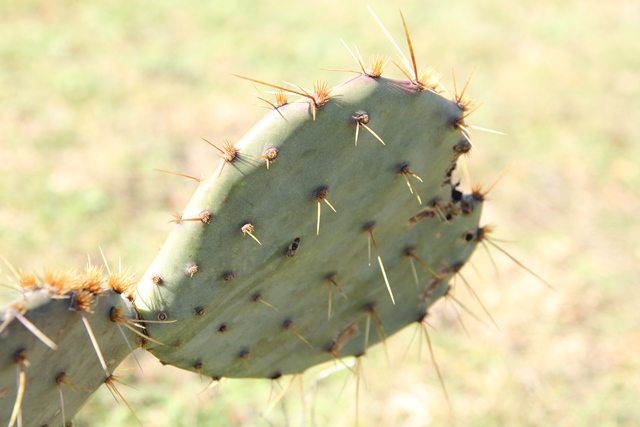
To begin his project, Don took a boat trailer, removed the rollers, and mounted an LP Tank on the back to make it very portable.
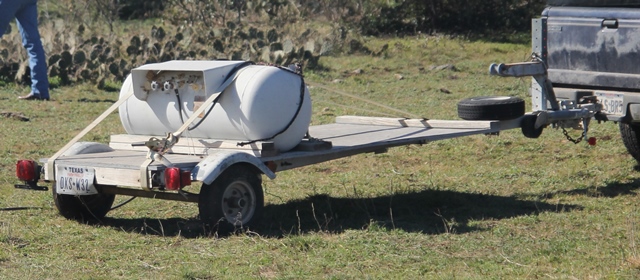
He uses a long burner arm to be able to reach into large patches of the cactus. It sounds and acts a lot like our flame weeder, only it is made for walking around with.
He burns the spines one side at a time, giving the smoke time to clear in between passes in order to make sure he isn’t missing any plants.
Here you can see the spines that are on fire. This is a very quick, effective way to remove the spines.
Notice the difference in color between the cactus in the foreground, and those in the back. When the flame is applied to the plant, it is lightly cooking the plant as well. Don flames enough cactus for one or two days of foraging, otherwise it rots before the cattle have a chance to use it for food.
In this close up, notice how shiny the outside of the plant looks compared to the first photo.
This is what the inside of the plant looks like – moist, and ready to eat. Cactus has a high water content, and is useful for its carbohydrates. The cattle are also fed a pelletized feed and minerals to balance out their diet.
Don has 25 head of cattle in this pasture, and they all were just waiting for us to move a little out of the way so they could get at the plants.
One person on our tour asked if the cattle like to eat the cactus. It was pretty obvious that they do when they all ran over to the patch and dug right in.
It was fun and interesting to see someone else using flames for a very different purpose than what we use it for.
We appreciate the American Farm Bureau for lining up tours to showcase agriculture in a different region, and to help bring an understanding that while we all are different, our roots are the same.
The post A Look at What One Rancher is Cooking Up for His Cattle appeared first on Carolyn CAREs.
]]>The post 30 Days of Thanksgiving – Day 22: Technology appeared first on Carolyn CAREs.
]]>
Have you ever driven past a field and noticed that the person driving the tractor didn’t have their hands on the steering wheel? Look for a globe similar to the one on the left, and you will know that they are using AutoSteer technology.
Jonathan and I have been using the AutoSteer system for about 5 years. We like to use the same wheel tracks for planting, dragging, rotary hoeing, and cultivating to reduce soil compaction. This system allows us to do that. If you look at the right hand photo, you will see lines on the monitor. We are able to skip lines when we’re working so we don’t have to turn as tight. The dark blue areas are where we’ve been, and the gray is where we need to go yet. The system allows us to record every pass in the fields, so we can keep records of planting dates, and weed control dates.
The GreenStar system works on our combine, and uses the same globe and monitor. We are able to record our yields…when the yield monitor is working…as well as use the AutoSteer. This year, I was very thankful for the whole guidance system. We had a wind storm that blew many acres of corn down in our county, including ours. Being able to set the combine on a line and not worry about staying on the row made harvesting the downed corn a lot easier! Some of my friends and family will think I’m mostly thankful for the AutoSteer so that I can text, Tweet, and Facebook. Really, that is just the icing on the cake.
To follow other 30 Day Blog Challenge participants, click here.
- Introduction to the 30 Day Challenge
- Day 1: Family
- Day 2: Harvest
- Day 3: Music
- Day 4: Bacon
- Day 5: Flowers
- Day 6: Coffee
- Day 7: Farmers
- Day 8: Photography
- Day 9: Winter
- Day 10: Reunions
- Day 11: Veterans
- Day 12: AgChat
- Day 13: Baking
- Day 14: Sunsets
- Day 15: Pongo
- Day 16: Laura
- Day 17: Bonfires
- Day 18: Social Media
- Day 19: Baseball
- Day 20: Parents
- Day 21: OATF
The post 30 Days of Thanksgiving – Day 22: Technology appeared first on Carolyn CAREs.
]]>The post Top 10 Things I Love About Farm Life appeared first on Carolyn CAREs.
]]>10. Fresh pork. We are pig farmers, so we always have a freezer full of fresh pork. Bacon and pork chops have to be the favorites. Grilled pork chops and Marshall Salad pair very well together. Follow the link for the salad recipe, shown here with Beef Strip Steaks to show a little love to our beef friends.

9. Spring. After long winters of snow, ice, and wind, it is so good to be able to work outside in just a long sleeved shirt. The smell of freshly turned soil is so awesome. After the crops are planted, waiting for the first shoots to push through the ground seems to take forever. Suddenly, there is a green haze over the fields. We wait eagerly for the first signs that you can “row” a crop.

8. Watching crops grow. Growing our crops is our business, but that doesn’t mean we’re on autopilot like some robotic device. I worry. A lot. I worry about getting enough rain, too much rain, hail storms, wind storms. In the fall, I worry about early snow storms. There are things we can do to give our crops the best chance at reaching their full potential: testing the soil and the manure to make sure we are applying the correct amount of manure in the fall, using cover crops to hold top soil in place over the winter, waiting to plant until the soil temperatures are ideal in the spring, and timing our weed control methods to have the least impact on the plants (check out this flame weeding video for one of our methods). The rest I shouldn’t worry about, but I’ll admit, I have troubles giving all of that to God.
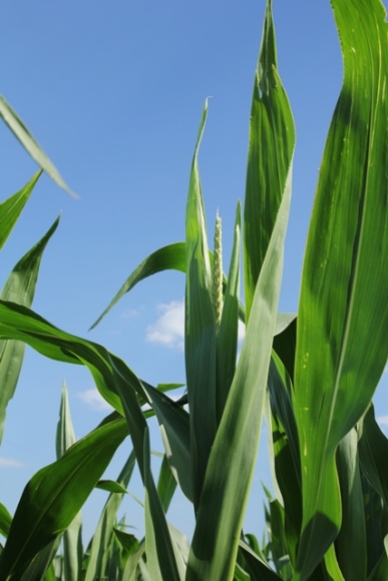
7. Meeting cool people. Jonathan and I have had the privilege of meeting some pretty cool people because we sell some of our corn to a place that makes vodka. Dean Phillips, of Phillips Distilling has visited our farm, and learned about the combine, and what it takes to grow the corn they use. Joe and Connie from Chatham Imports have also visited our farm, learning about us and what it is we do. You can read about that in this series -The Power of Bundt Cake Part 1, Part 2, Part 3, and Part 4. There have also been a few advertising agencies that we have met. Jonathan was even interviewed for the Prairie Vodka website. That was a pretty cool experience.

6. Work hard, play hard. We love getting together with family. If it is at a lake, all the better. I like to relax a bit and fish, but Jonathan loves to play on the jet skis. We look forward to the few days in the summer where we are free to leave the farm and relax.
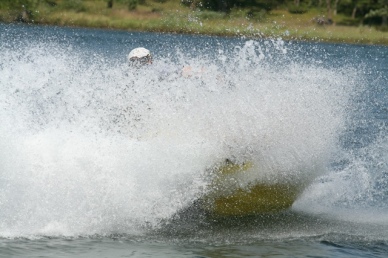
5. Wildlife. Who doesn’t like to watch wild animals in their habitat? This year, I have watched a fox and her two kits near our grove of trees, a doe and her fawn grazing in our yard, and a coyote who casually walked away while I was working in a field near it’s home. I have watched a dozen hawks circle in the sky while preparing soil for planting, I watched a cicada drying its wings after its metamorphosis, and have seen butterflies softly flitting around in the yard. Watching the wildlife makes me appreciate the beauty all around us.
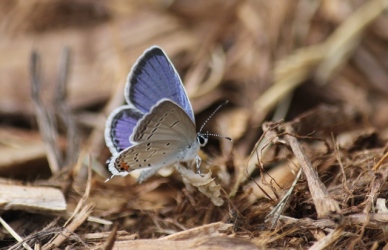
4. Sunsets. Living on the prairie has its advantages. The skies are endless, and most nights we are treated to wonderful sunsets. In the summer, the sunsets seem to go on forever. To see some gorgeous North Dakota sunsets, visit my friend, Katie Pinke’s blog. She has a blog post about 14 Late Summer North Dakota Sunrises and Sunsets. One thing I love about working outside in the evening, is the way the skies can change so quickly. From a flaming red and orange, to a soft pastel pink, to a mix of purple and deep pinks all a matter of minutes.
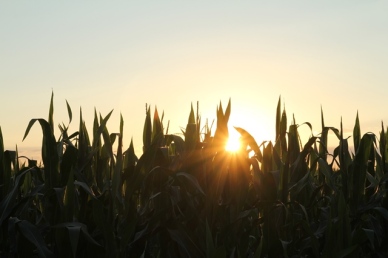
3. Driving large pieces of machinery. I was not meant to drive a little car like a Toyota or a Honda. I like to drive tractors and combines. You can see more when you are sitting up high. Maybe that’s why I like driving pickups more than cars. I do love my minivan, but I get a little embarrassed when we bring it in for an oil change and there are corn stalks stuck on the bottom from driving out to the combine. I was pretty nervous to learn how to drive the combine, but now I love it! We had our combine all set up for our Century Farm Celebration and our county’s I Met a Farmer Tour. It’s a fun way to introduce people to farming, and they think it’s cool that I get to drive it.
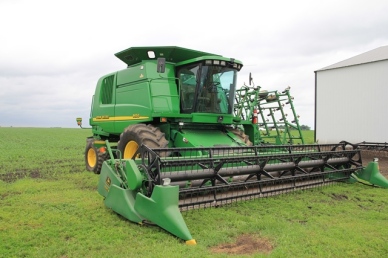
2. Harvest! I love harvest. This is the time of year when we see the results of all the labor that was put into the crop throughout the growing season. When we plant the seeds in the spring, we are hopeful that we will have favorable weather, few bad storms, and be able to harvest enough so we will be able to farm again next year. We are thankful for every bushel of grain that goes into the bin. Yes, the hours are long, the pace is frantic at times, and there is always the worry of an early snowstorm, but those are the things that keep it from being boring. This is one of my favorite harvest photos, paired with a harvest prayer. It was also shared as a Wordless Wednesday photo a few weeks ago.
So, what is the number 1 thing I love about farm life?
1. Working every day with my best friend, Jonathan. Yeah, yeah. It’s sappy, I know. But I wouldn’t trade this life with anyone. Jonathan and I celebrated our 25th Wedding Anniversary in August. We were married during a drought year, so we came home from our honeymoon a day early to help with corn harvest. This city girl learned quickly how to move wagons, and unload the corn into the bins. Jonathan and his dad are very patient teachers, which made the transition so much better. I later graduated to running the stalk chopper, then the chisel plow, the field cultivator, and finally the combine. With every new skill, Jonathan has been able to calm my nerves, and give me confidence to tackle the next big thing. I have grown from a shy 20 year old newlywed into a mouthy 40 (something) gray haired lady. I don’t think he regrets that. I don’t care what you want to do in life, a supportive family makes it much easier. To Jonathan, thank you for being a great man of God, husband, teacher, jokester, and friend. I love you!

The post Top 10 Things I Love About Farm Life appeared first on Carolyn CAREs.
]]>










